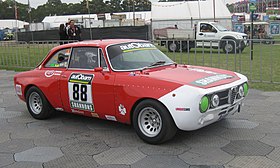Alfa Romeo GTA
| Alfa Romeo GTA | |
|---|---|

Alfa Romeo Giulia GTA (road version)
|
|
| Overview | |
| Manufacturer | Alfa Romeo |
| Also called | Alfa Romeo Giulia GTA |
| Production | 1965–1969 |
| Body and chassis | |
| Class | Sports car |
| Body style | 2-door coupé |
| Layout | Front-engine, rear-wheel-drive |
| Powertrain | |
| Engine | Alfa Romeo Twin Cam I4 |
| Transmission | 5-speed manual |
| Chronology | |
| Predecessor | Alfa Romeo Giulietta Sprint |
| Alfa Romeo GTA 1300 Junior | |
|---|---|
 |
|
| Overview | |
| Production | 1968–1975 |
| Powertrain | |
| Engine | 1.3 L Twin Cam I4 |
| Alfa Romeo GTAm | |
|---|---|
 |
|
| Overview | |
| Production | 1969–1971 |
| Powertrain | |
| Engine | 2.0 L Twin Cam I4 |
|
|
|
|
|
| Alfa Romeo GTA-SA | |
|---|---|
| Overview | |
| Production | 1967–1968 |
| Powertrain | |
| Engine | 1.6 L supercharged Twin Cam I4 |
|
|
The Alfa Romeo GTA is a coupé automobile manufactured by the Italian manufacturer Alfa Romeo from 1965 to 1971. It was made for racing (Corsa) and road use (Stradale).
In 1962, the successor for the very popular Giulietta series was introduced. This car was the Alfa Romeo Giulia, internally called the "Series 105". The coupé of the 105 series, used the shortened floorpan from the Giulia Berlina and was designed by Bertone. The name of the car evolved from Giulia Sprint GT to Giulia Sprint and to GTJ (Junior) and GTV (Veloce) in the late 1960s.
At the time, Alfa was very active in motorsport. Autodelta, the racing division of Alfa, developed a car for competition that closely resembled to the roadgoing model. These cars were named GTA instead of GT, the 'A' standing for "Alleggerita", Italian for lightweight. The GTA was produced first in 1965 as a 1600 (1570 cc) and later as a 1300 Junior version. The GTA automobiles were also manufactured in either street (Stradale) or pure race (Corsa) trim.
The GTA had aluminium outer body panels instead of steel, (the inner steel panels were also of thinner gauge, the inner and outer panels were bonded and pop-riveted together), magnesium alloy wheels, clear plastic side windows, an aluminium rear upper control arm, different door handles and quarter window mechanisms, and lightweight interior trim. The engine had a new double ignition cylinder head (called twin plug, later in the eighties the system was called twin spark) cylinder head with a Marelli distributor from a Ferrari Dino, 45 mm carburetors instead of 40 mm and magnesium camshaft cover, sump, timing cover and bell housing. The transmission gear ratios were closer than standard and the gears were machined for lightness and quicker shifting. Dry weight of the 1600 was approximately 1,640 pounds (740 kg). In stradale form this car boasted approximately 115 PS (85 kW; 113 hp) (up from 106 PS (78 kW; 105 hp)). In full race form this engine could produce up to 170 PS (130 kW; 170 hp). The 1600 GTA did not have a brake booster and had a thicker radiator than the standard vehicle. For homologation 500 cars were made for racing and road use.
...
Wikipedia
